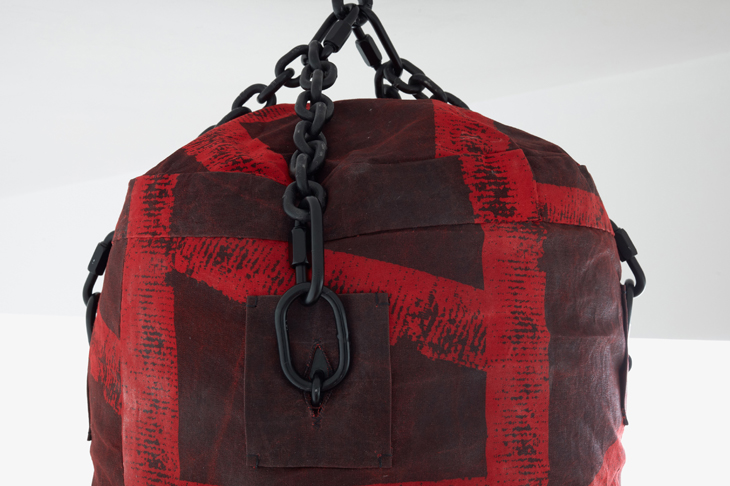‘It’s a punch bag, but it’s not really to be punched.’ Eva Rothschild is talking about the first work we encounter in her exhibition of new sculptures at Stuart Shave’s Modern Art in London. It’s clear what Rothschild means. Nearly five metres tall, the punch bag in question is, in its literal form, a punch bag. But it’s also a crafted sculptural object, the artist’s hand a clear presence on the hand-dyed wax fabric surface, which is patterned with intersecting lines made using the application of gaffer tape.
The sculpture, Iceberg Hits, is also the titular work in the exhibition. For Rothschild, her titles never seek to explain the work; rather, they are intended to generate an aura of associations around her sculptures. Here, the most obvious linguistic allusion – it is hard not to think of the collision that sunk the Titanic in 1912 – might not be so far from the mark. Rothschild suggests that an iceberg might function as a metaphor for our current socio-political situation: just ten per cent of an iceberg may be visible, but the effects of ignoring it could be catastrophic. What it is exactly ‘that has to be dealt with’ isn’t named explicitly in our conversation but the implications are apparent. Like the title, the form and materiality of Iceberg Hits are rich in allusion. There is the comedic reading of the work as a phallic totem to be knocked down, as well as a sense of rage and the potential for catharsis: ‘It was made by the hand and can be acted on by the hand. […] Through that activity, you become stronger’.
Cosmos and Border (both 2018), Eva Rothschild. Installation view at Modern Art, Vyner Street, London, 2018. Photo: Robert Glowacki; courtesy Stuart Shave/Modern Art; © the artist
Iceberg Hits is one of three monumental sculptures in the ground-floor space of the gallery. Although comparable in scale, the works each explore different materials and processes. For Border, Rothschild worked with concrete blocks to create a weighty, cuboid structure, upon which she painted bright green triangular patterns, reminiscent of hazard signs. The work draws from the artist’s upbringing near the sea in Dublin, and ‘the signage you see around coastal architecture’. Rothschild wanted to make ‘something really solid, which is then broken up through colour: a minimalist painting, almost’.
The third work, Cosmos, also highlights Rothschild’s interest in colour as a sculptural tool. The work is constructed of bars of perforated black steel, their surfaces spray-painted in cool, lustrous hues of teal, purple and blue. The open lattice form allows the viewer to enter into the sculpture, while the careful, graded application of colour distorts your perspective as you walk in and around it. ‘I was inspired by images from the Hubble space telescope for the colours’, Rothschild explains. The sculpture seems to expand and contract, recalling the ever-expanding nature of the cosmos. It is a mark of Rothschild’s virtuosity that this work, along with the two other sculptures in the space, holds the room so powerfully.
Tooth and Claw (2018), Eva Rothschild. Photo: Robert Glowacki; courtesy Stuart Shave/Modern Art; © the artist
Upstairs, a second series of six sculptures on a smaller, more human scale strikes a different tone. Each work is placed on a plinth or support structure; Rothschild describes them as hovering ‘between still life and architecture’. They also reveal a closer connection to the artist’s hand and body – not least in the work Tooth and Claw, a sort of votive display including a cast of the artist’s arm. This arm is a reference to David’s Death of Marat from 1793, a copy of which has been on the wall of Rothschild’s studio for a long time.
Marat’s image is also evoked in Hangouts, which sees Rothschild take casts of clothing (found fabrics, sportswear) by dipping materials in jesmonite – a contemporary riff on the meticulously rendered drapes and folds of neoclassical painting. A similar modern-day reframing of art-historical tradition is suggested in a nearby work, Yr Crystal Brain: a tall stack of porous blocks made of fibreglass and polyurethane. These sculptures, Rothschild says, are designed to ‘mimic the classical monumental form’, yet frequently employ disposable materials such as polystyrene, throwaway fashion, plastic bottles and cans. Her point? While we think of these items as single-use, materials like plastic or polystyrene – ‘the things we will leave behind’ – are as long-lasting as marble. As an artist, Rothschild relates this to her own ‘cognitive dissonance around making’. ‘We’re adding and adding all the time. So I try not to buy much stuff.’
Hangouts (2018), Eva Rothschild. Photo: Robert Glowacki; courtesy Stuart Shave/Modern Art; © the artist
‘My works don’t exist in a vacuum, personally or politically’, Rothschild asserts. But she also says that she would not go in for any topic unless it had some kind of sculptural appeal. Given the technical, procedural difficulty of her sculptures, she works astonishingly quickly, with almost everything for this exhibition realised within the last six months. This nimbleness allows her sculptures to remain in dialogue with contemporary reality.
‘Eva Rothschild: Iceberg Hits’ is at Modern Art, London, until 5 May.
